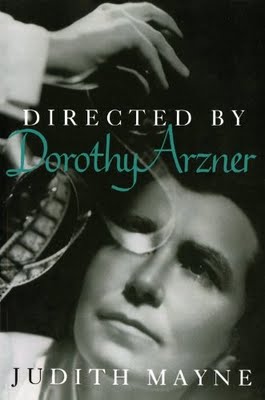 |
| Directed by Dorothy Arzner by Judith Mayne |
In the early to mid-1970s, when Arzner’s work was brought to the attention of feminists, her films were deemed particularly important for their criticism of Hollywood films “from within.” Pam Cook and Claire Johnston described how the universe of the male was “made strange” in Arzner’s films, how women’s “rewriting” of male discourse subverted the established conventions of Hollywood. At the time Cook and Johnston’s essays were published, film theory was very much preoccupied with the notion of “making strange,” with the possibilities of a Hollywood film that critiqued itself and its own assumptions. Cook and Johnston brought a strong theoretical approach to Arzner’s work, while other critics of the era were simply delighted to find a woman director among all of the men in Hollywood film history.
The plot of Dance, Girl, Dance concerns the differing paths to success for Bubbles (Lucille Ball) and Judy (Maureen O’Hara), both members of a dance troupe led by Madame Basilova (Maria Ouspenskaya). The dance troupe performs vaudeville-style numbers in bars and nightclubs, much to the chagrin of Basilova (who bemoans her status as a “flesh peddler”). Bubbles has “oomph,” a kind of dancer’s version of “it,” and eventually she leaves the troupe and enthusiastically pursues a career as “Tiger Lily White.” Judy, in contrast, is a serious student of ballet, and the protegee of Basilova. However, it is Bubbles who gets the jobs, and she arranges for Judy to be hired as her “stooge,” i.e., as a classical dancer who performs in the middle of Bubble’s act, and thus primes the audience to demand more of Bubbles.
Toward the end of the film, Judy stands on stage and refuses her role as stooge. She defiantly crosses her arms and moves closer to the audience, and she gives the spectators a piece of her mind:
Go ahead and stare. I’m not ashamed. Go on. Laugh! Get your money’s worth. Nobody’s going to hurt you. I know you want me to tear my clothes off so’s you can look your fifty cents worth. Fifty cents for the privilege of staring at a girl the way your wives won’t let you. What do you suppose we think of you up here–with your silly smirks your mothers would be ashamed of? And we know it’s the thing of the moment for the dress suits to come and laugh at us too. We’d laugh right back at the lot of you, only we’re paid to let you sit there and roll your eyes and make your screamingly clever remarks. What’s it for? So’s you can go home when the show’s over and strut before your wives and sweethearts and play at being the stronger sex for a minute? I’m sure they see through you just like we do.
I see Judy’s confrontation less as a challenge to the very notion of woman as object of spectacle than as the creation of another kind of performance. Oftentimes the scene is discussed as if the audience were exclusively male, which it is not, even though Judy addresses men in her speech. When the camera pans the reactions of the audience to Judy’s speech, the responses of women are quite clearly visible. Women squirm uncomfortably in their seats just as surely as men do, and when release occurs in the form of applause, it is a woman–Steven Adams’s trusty secretary–who initiates it. Arzner’s view of performance and her view of the relationship between subject and object were never absolute; women may be objectified through performance, but they are also empowered; men may consume women through the look, but women also watch and take pleasure in the spectacle of other women’s performance.
Thoughts?
